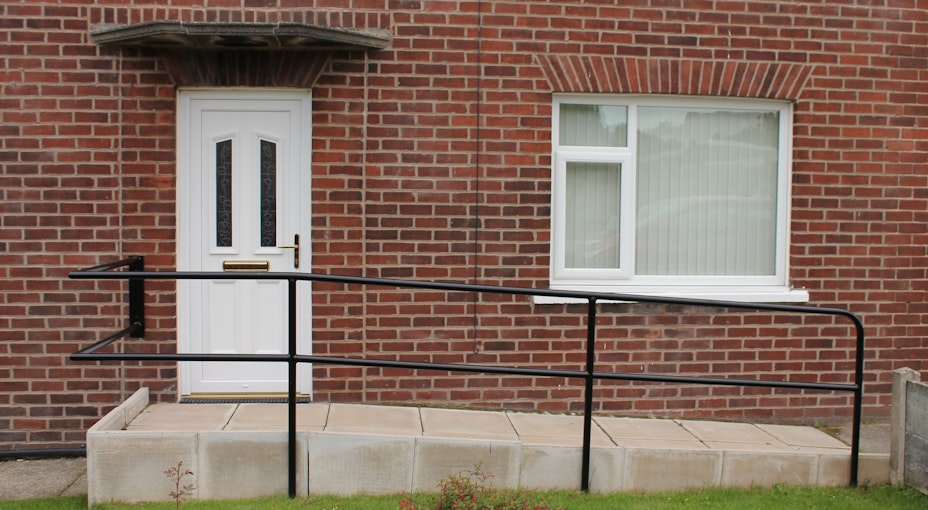Landlord guide to renting to disabled tenants
By Alan Boswell Group

- Do landlords have to accommodate tenant’s disabilities?
- What’s considered a ‘reasonable adjustment’?
- What kind of alterations will I be expected to make?
- What is considered an ‘unreasonable’ alteration?
- How can I adapt my property for a disabled tenant?
- Can a landlord refuse adaptations?
- Do landlords have to provide disabled parking for tenants?
In this article
- Do landlords have to accommodate tenant’s disabilities?
- What’s considered a ‘reasonable adjustment’?
- What kind of alterations will I be expected to make?
- What is considered an ‘unreasonable’ alteration?
- How can I adapt my property for a disabled tenant?
- Can a landlord refuse adaptations?
- Do landlords have to provide disabled parking for tenants?
An estimated 16 million people in the UK live with a disability, according to a 2021-2022 survey by the Department for Work and Pensions (DWP).
Despite nearly one quarter (24%) of the population having a disability, the Equality and Human Rights Commission (EHRC) found that only 7% of homes in England provided basic accessibility features.
The EHRC also revealed that one in three disabled people who rent privately live in unsuitable accommodation. In social housing, it’s one in five. So, while tenants with disabilities are more likely to struggle to find suitable homes in general, it’s even harder within the private rented sector.
Under the terms of the Equality Act 2010, landlords cannot discriminate against tenants with disabilities. Landlords are also expected to consider any ‘reasonable adjustments’ to ensure that tenants’ needs are met.
We look at what your landlord responsibilities and obligations are, what counts as a reasonable adjustment, and whether if it’s ever acceptable to refuse adaptations.
Do landlords have to accommodate tenant’s disabilities?
The short answer is yes. Under the terms of the Equality Act 2010, if a tenant has a disability, you’re expected to make reasonable adjustments to accommodate their needs.
Specifically, it means that you’re expected to make adjustments in the way you do things (for example, the way you communicate) or to the property itself (if it’s fair and reasonable to do so).
You’re also expected to consider any requests for auxiliary aids (equipment that helps a tenant with a disability). This could include providing ramp access, handrails, or a tenancy agreement in large print or Braille.
What’s considered a ‘reasonable adjustment’?
This can be tricky to define as ‘reasonable’ is open to interpretation, but it often comes down to affordability, practicality, and the length of the tenancy.
For example, if you’re a career landlord with a high turnover, you may be expected to accommodate more changes than a part-time or accidental landlord with a smaller budget. You’ll also need to weigh up the length of the tenancy and how disruptive changes might be for other tenants.
An example of a reasonable adjustment could be a tenancy agreement written in large print and issued on paper, if a tenant struggles to read small print or from a screen. Similarly, providing handrails or switching from standard to accessible taps are relatively minor and inexpensive changes that can be of great help to your tenant.
What kind of alterations will I be expected to make?
Older homes in the UK aren’t designed with accessibility in mind, and reasonable adjustments will vary depending on your property and circumstances.
We’ve listed some key areas to consider and possible adaptations. Bear in mind that some of these alterations could be considered major changes, so they won’t all apply to you or your property, depending on your situation.

Entry and access points
Camera or intercom doorbells that tenants can access without moving
Permanent or removable ramps and handrails
Providing accessible pathways
Widening doorways
General interior modifications
Adding a doorbell with a flashing light for tenants who are deaf or hard of hearing
Improved lighting for the visually impaired
Providing non-slip flooring to minimise the risk of accidents
Lowering light switches or raising sockets
Creating an open floorplan to accommodate wheelchair users
Installing a stairlift if tenants are in a block of flats or if the property is multi-level
Bathroom adaptations
Installing a raised toilet seat
Adding grab bars near the toilet, shower or bath to enable independence
Switching from standard to accessible fixtures, such as lever taps or a handheld showerhead
Providing a walk-in shower or wet room
Kitchen adaptations
Changing fixed shelves and cupboards to pull-out shelves or drawers
Installing accessible appliances that are easy to reach
Lowering countertops and sinks for wheelchair users
Safety features
Ensuring fire alarms and detectors are adapted for tenants with visual or hearing impairment
Checking escape routes are accessible
What is considered an ‘unreasonable’ alteration?
Currently, you’re not expected to make major physical changes to the property, for example, knocking down walls or widening doorways, unless you want to.
You can also refuse to make alterations in certain circumstances:
If the property you rent had been your main home and you manage it as a rental yourself.
If your tenant shares living facilities with others (kitchen, bathroom or living room).
If you or a member of your family also lives in the property.
If the property isn’t big enough to house more than six tenants or two separate households.
How can I adapt my property for a disabled tenant?
Suitable adaptations will vary depending on the tenant’s disability, so what you must consider will vary from tenant to tenant.
Your tenant should also discuss any changes they need with you, and they must have your permission before alterations take place.
Who pays for adaptations?
As the landlord, it’s your responsibility to cover the cost of any reasonable adjustment.
Tenants can offer to cover the cost of alterations themselves, but if the request is considered reasonable, you can’t ask them to pay for it.
Can a landlord refuse adaptations?
Under certain circumstances you can refuse an alteration, but you must put this in writing and explain why you can’t make the adjustment.
If you don’t have a good reason or don’t respond to their request within a reasonable amount of time, your tenant may be entitled to take this as consent should they choose to pursue it legally.
Can I agree to adaptations but with conditions?
Yes. You can specify conditions as long as they’re fair and reasonable. For example, if your tenant requests a guide dog, you can ask to carry out property inspections, or that they take out pet damage insurance. Inspections should take place at reasonable intervals (six months or annually); more frequent inspections could be considered unreasonable.
Do landlords have to provide disabled parking for tenants?
If the property has a parking space that your tenant wants to use, then it’s your responsibility to ensure they can. For example, if the property has a driveway lined by hedges that make it difficult for your tenant to access their car, a reasonable request might be to remove the hedges.
If there is no off-street parking, it’s up to the council to provide a disabled bay, but your tenant will need to meet certain conditions. Most councils will have an application form online (or your tenant can request a paper copy).
Meeting your obligations and landlord insurance
As a landlord, you must ensure your rental property is safe and free from health hazards. It’s also your responsibility to make any reasonable adjustments for tenants with disabilities. Not doing so can count as discrimination.
If you have landlord insurance, you’ll also be expected to fulfil your legal obligations. If not, it could invalidate your policy and your insurer can reject a claim you make. With that in mind, it’s good practice to keep landlord certificates (such as gas safety and an EPC) and records of correspondence readily available as evidence should you need it. You may also want to consider taking out landlord legal expenses insurance, which provides cover for legal expenses and a 24/7 legal helpline should you need advice relating to property alterations or any other matter.
For more about what landlord insurance includes and how it can help you manage your rental with peace of mind, take a look at our landlord insurance hub.
Need help with your insurance?
To learn more about how insurance can protect your property and rental income, speak to our team.
Make an enquiry
Related guides and insights

A landlords guide to sitting tenants
Sitting tenants can complicate a sale, but that doesn’t always have to be the case. We explore how sitting tenants can affect your property and what you can do to make the sale process as smooth as possible.

Commercial landlord responsibilities
If you own a commercial property for rent, you’ll know it comes with certain responsibilities. But there's often confusion about who is responsible for what; landlord or tenant?

A guide to understanding landlord harassment
Landlord harassment is essentially anything a landlord does that prevents tenants from living peacefully in their homes. Examples of landlord harassment in the UK vary widely but includes incidents such as changing the locks without tenants’ knowledge.
